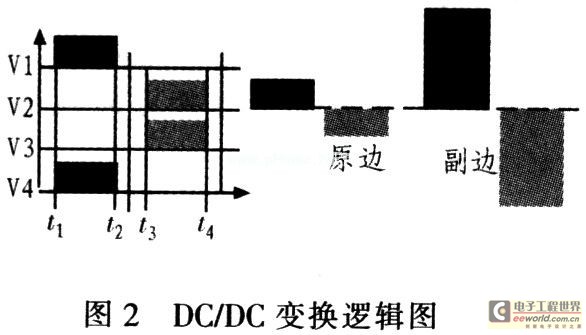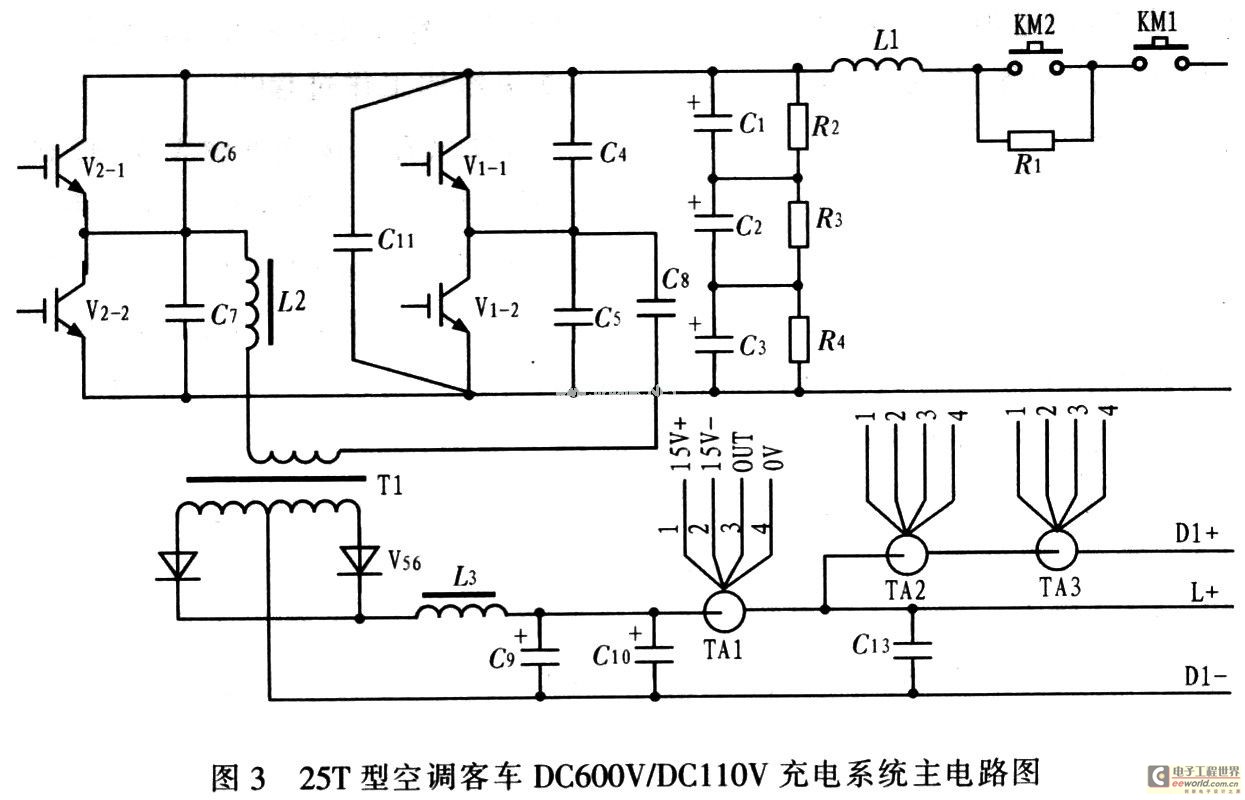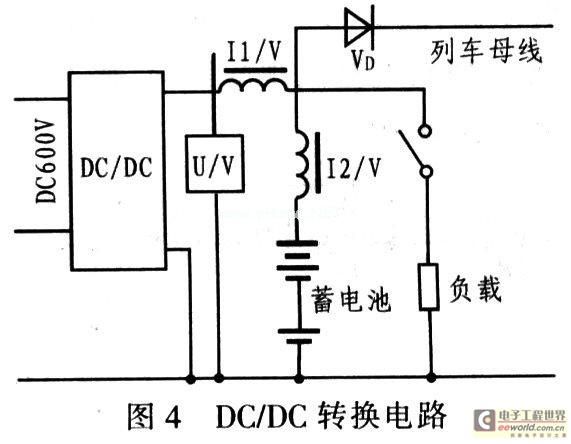Application Research on DC600V DC110V8kW Charging System of 25T Air-conditioned Passenger Car
1 Introduction
The DC600V / DC110V8kW charging system is a special system designed for the 25T passenger car of the DC600V power supply system. The charging system consists of an 8 kW charger module and a 3.5 kV · A single-phase inverter module. The bus battery provides a source of floating charge. At the same time, it supplies power to other DC loads for battery charging and lighting control systems.
2 System composition
The DCT 600V / DCI110V 8 kW charging system of this 25T air-conditioned passenger car is composed of two parts: stand-alone and cabinet. Among them, the stand-alone part mainly has the main circuit and control circuit; the cabinet part includes external incoming terminals, input and output circuit fuses and control. Air switch etc.
2. Analysis and realization of PWM high-frequency bridge inverter main circuit
DC600V / DC110V 8 kW charging system has an input voltage of DC600 V and a power of 8 kW. It adopts a Bridge Rectifier circuit and a high-power DC / DC conversion circuit suitable for high-voltage conversion. Figure 1 shows the system PWM high-frequency bridge DC / DC conversion. Circuit schematic. The entire system consists of input isolation, filtering and buffer circuits. The inverter bridge is composed of 4 IGBTs. The high-frequency transformer transmits power, and the transformer output is supplied to the DC load and battery after high-frequency rectification and filtering. Figure 2 is the control logic of the main circuit of DC / DC conversion composed of V1-V4 and the logic waveform of the primary and secondary voltages of the transformer: in the interval of t1-t2, V1 and V4 are turned on, and the primary voltage of the transformer is the positive phase voltage; In the interval of ~ t4, V2 and V3 are turned on, and the primary voltage of the transformer is the reverse voltage.


Figure 3 shows the main circuit of the DC600V / DC110V charging system of a 25T air-conditioned passenger car. Analysis of Figures 2 and 3 shows that the primary of the high-frequency transformer of the switching element IGBT power module (V1, V2) is connected to the diagonal of the bridge via the isolated DC capacitor C8 and the inductor L2. The transformer secondary is connected to a full-wave rectifier (V56) and filters L3, C9, and C10 to output 119 to 123 V DC. The main control circuit uses a phase-shift control integrated circuit, UC3875 (UC2875) as the control device, and outputs two sets (A-B, C-D) of 180 ° complementary and lagging, adjustable time IGBT gate trigger signal. Further analysis shows that the system does not turn on all IGBTs in the interval t2 to t3. This period is called the "dead zone" to prevent the two IGBTs of the upper and lower bridge arms from turning on at the same time and causing the bridge arm to "through" a short circuit.

When designing the system, the IGBT used in the charger is generally dual-unit, that is, the two IGBTs of the upper and lower arms are integrated in a module. Although the circuit structure is simple, because the IGBT is operated at a high frequency, it is generally around 20 kHz, so its switching loss Large, difficult to dissipate heat. In order to solve the problem of high-frequency switching loss, the system uses phase-shifting technology to realize quasi-soft switching control of IGBT. The phase-shifting soft switching circuit has the advantages of unchanged working frequency, simple control, high efficiency and low interference. The principle of phase-shifting control: using the capacitor resonance between the leakage inductance of the transformer and the IGBT junction, during the release of the energy storage of the leakage inductance LK to the capacitor C, the voltage of the capacitor C gradually drops to 0, and the diode VD conducts, creating a 0 voltage switch (ZVS ) Conditions, other inductance and capacitance elements in the circuit are set for reliable zero-voltage switching. The upper and lower switch tubes (V1 and V2, V3 and V4) of the left and right arms of the bridge are given 180 ° complementary drive signals, and the upper and lower tubes are complementary turned on at 180 °. In addition to the dead zone where the upper and lower tubes are conducting, there are always two switching tubes conducting at the same time in the circuit, a total of 4 kinds of conducting combinations, namely V1 and V4, V4 and V2, V2 and V3, V3 and V1, and click here The sequence repeats. Among them, when V1 and V4, V2 and V3 are combined and turned on (that is, diagonally turned on), the full-bridge circuit gives energy, and V3 and V1, V4 and V2 are combined and turned on (that is, the upper arm or the lower arm When both tubes are turned on at the same time), the full-bridge circuit is in a freewheeling state and does not output energy. Adjusting the time ratio of these two combinations, namely the phase shift angle, the transformer gets an alternating PWM voltage, thereby adjusting the output voltage and current.
2.2 Functions and characteristics of DC / DC conversion
In order to reduce the size of the charger and prevent the high voltage from entering the low voltage system, the system uses a high-frequency insulated DC / DC converter. Figure 4 shows its circuit diagram.

The DC / DC charger is used to transform the input DC 600 V into DC110V suitable for battery charging and DC load. When the input voltage and load change, the output is stabilized to realize the voltage stabilization function. The input protection and working principle of the DC / DC charger are the same as the inverter, and the DC600V voltage is converted into a high-frequency square wave voltage with adjustable duty cycle through the IGBT bridge inverter circuit. Duty cycle refers to the ratio of the pulse width of the driving IGBT to the whole half-wave period within a half-wave. In order to adjust the output voltage, the duty cycle is variable and belongs to the PWM mode with adjustable pulse width.
In this control mode, the amplitude of the pulse is unchanged. When the load changes, the pulse width is changed to ensure the stability of the output voltage; if the input voltage changes, the pulse width can also be changed to ensure the output is stable. After transformer isolation, it is rectified and filtered into DC 110 V voltage; for some compatible power supply 25T railway passenger cars, the AC 380 V is rectified into DC 540 V, and then the same DC / DC conversion as DC 600 V is adopted. The rectifier circuit composed of four high frequency fast diodes VD1 ~ VD4 rectifies the pulse voltage output from the secondary side of the transformer, and is filtered by the reactor L and capacitor C.
Because high-frequency rectification requires a small on-state voltage drop to reduce conduction losses, it also requires fast turn-on and turn-off capabilities to reduce switching losses, because at high frequencies, the diode conduction The loss caused by the reverse recovery time accounts for a significant proportion of the total loss.
The characteristics of DCfDC conversion: the use of voltage and current double closed-loop control to achieve constant current and constant voltage charging of the battery; the use of soft switching technology to reduce the IGBT high-frequency switching loss, the efficiency reaches 92%; the use of advanced amorphous iron core to make transformers and reactors Reduce the size of the charger; the switching frequency of the IGBT is above 20 kHz, avoid the audio area, reduce the electromagnetic noise of the charger; the battery charging adopts temperature compensation measures; the charger has fault diagnosis and communication functions, and the touch screen of the control cabinet can display charging Operating parameters and fault information of the device.
3 The working process of the system
3.1 Examples of basic working principles
Figure 5 is a schematic diagram of the input circuit of the charging system. Working process: DC 600 V input +610 V, ï¼610 V, enter the charger via Fuse, contactor KM1, KM2, charging resistance R1, input filter inductance L1, input filter capacitor C1, C2, C3. When the bus voltage reaches 500 V, KM1 pulls in and charges capacitors C1, C2, and C3 through R1. When the voltage on the capacitor is full, KM2 pulls in and conducts LC through input filter inductor L1 and input filter capacitors C1, C2, and C3. After filtering, a smoother DC voltage is obtained, which is then sent to the DC 600 V / DC 110 V straight-to-alternate conversion link for conversion. R1 and KM2 form a soft start circuit. When the input power increases suddenly, in order to avoid directly charging the input filter capacitors C1, C2, C3, the DC 600 V input must be limited by the metal film resistor R1. When the input capacitor is full, control the contact KM2 pulls in and then changes normally. When the charger fails, disconnect KM1 to disconnect the charger and the DC 600 V input.

In order to reduce the impact of the charger's starting work, the IGBT drive pulse of the charger also uses a soft start method when starting, that is, the pulse width gradually increases, the output voltage gradually increases, and when it reaches a certain value, voltage feedback or current feedback kick in.
The system has a current limiting and constant voltage charging function. Since the 25T bus uses alkaline medium rate batteries, the charging requirements for alkaline batteries should conform to the Markov curve, that is, the battery adopts constant current charging when the voltage is low, and when the voltage is charged to a certain level When using constant pressure floating charging method. According to the unified requirements of the Ministry of Railways, the current-limit charging value is (1 + 10%) × 25 A, the 25T passenger car battery is 120 A h, and the discharge current is 24 A at 5 h, so the constant current charging current is limited to (1 + 10 %) × 25 A, the end voltage of the alkaline medium-rate battery floating charge is 1.5 V, there are 80 batteries in the 25T passenger car battery, the charging voltage should be 120 V, considering that the upper limit of the voltage of most low-voltage electrical coils is ( 1 + 10%) × 110 V, that is 121 V, so the charging voltage may be low. During operation, 1 to 2 batteries can be properly reduced.
The output current of the charger is divided into three parts, one part charges the battery of the own car, the other part supplies the load such as lighting and control of the own car, and the other part supplies power to the train bus through the diode.
The current sensor I1 / V is a sensor that measures the total current output by the charger. When the output current of the charger exceeds its allowable current by 70 A, the driving pulse of the IGBT is controlled to narrow, so that the output voltage is reduced. After the output voltage is lowered, the charger will not Output current to other passenger cars, while reducing battery current and lowering total output current. Since the entire battery and charger are connected in parallel through diodes, the output voltage of each bus charger should be as consistent as possible.
3.2 The working process of the system
The system can work normally only when the wiring is accurate, the control power supply is normal, and the DC 600 V power supply is normal. After the system is connected to the control power supply, it starts to detect various states. If only the control power is turned on and there is no DC 600 V input, the power supply system will cyclically detect and display the battery voltage and its discharge current, and indicate the input voltage and battery voltage status (undervoltage or normal), while communicating with the gateway, will The corresponding information is passed to the PLC; if the control power supply and the input power supply voltage are DC 600 V, the converter starts to work, and the monitoring system simultaneously detects and displays the output voltage, load current, charging current of the power supply system and the working status of the converter. At the same time, it communicates with the gateway and transmits the corresponding information to the PLC.
3.3 Basic protection functions of the system
In order to make the system work efficiently, the system is designed for input undervoltage protection, output overload protection, input spike overvoltage protection, output overcurrent and short circuit protection, input mean overvoltage protection, output undervoltage protection, output peak overvoltage protection, heat dissipation The overheating protection of the device, the output mean overvoltage protection and the power switch tube overcurrent protection and other protection circuits. In addition, before installing or replacing the battery in the system, first confirm the correct polarity before wiring.
4 Conclusion
Compared with the traditional power supply of the same power, the system has the following characteristics: small size, light weight; high efficiency; high reliability; high power supply quality to the load: easy to use and maintain; use input and output LC filter circuit and soft start , Low interference to the power supply network, small output voltage ripple, and strong anti-interference ability. The charging system has reached the domestic advanced level.
Rectifier bridge is to seal the rectifier tube in a shell. Points full bridge and half bridge. The full bridge connects the four diodes of the connected bridge rectifier circuit together. The half bridge is half of four diode bridge rectifiers, and two half bridges can be used to form a bridge rectifier circuit. One half bridge can also be used to form a full-wave rectifier circuit with a center-tapped transformer. Select a rectifier bridge to consider. Rectifier circuit and operating voltage.
Bridge Rectifier
Bridge Rectifier,Original Bridge Rectifier,Full Bridge Rectifier ,Diodes Bridge Rectifier,Single Phase Rectifier Bridge, Three Phase Bridge Rectifier
YANGZHOU POSITIONING TECH CO., LTD. , https://www.yzpst.com